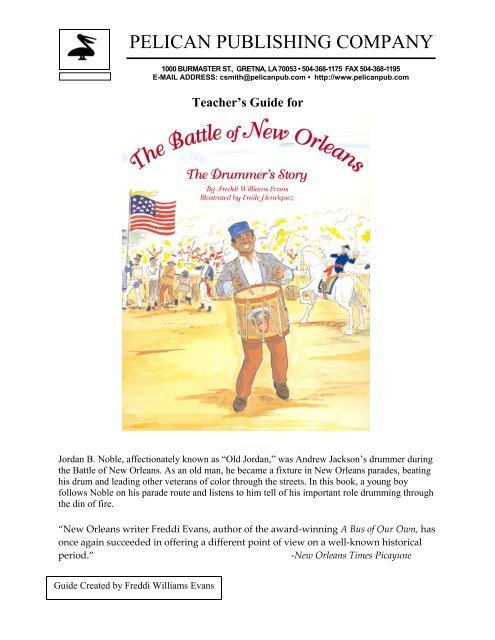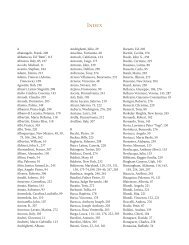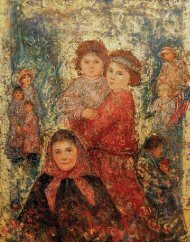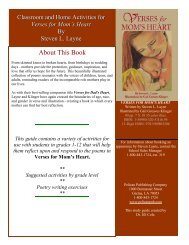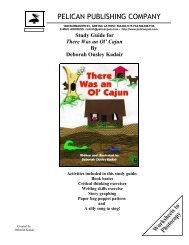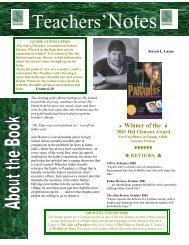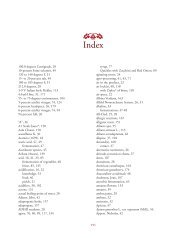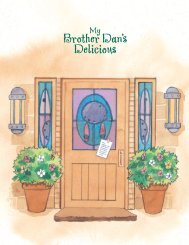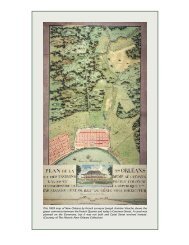the Battle of New Orleans study guide. - Pelican Publishing Company
the Battle of New Orleans study guide. - Pelican Publishing Company
the Battle of New Orleans study guide. - Pelican Publishing Company
You also want an ePaper? Increase the reach of your titles
YUMPU automatically turns print PDFs into web optimized ePapers that Google loves.
PELICAN PUBLISHING COMPANY<br />
1000 BURMASTER ST., GRETNA, LA 70053 • 504-368-1175 FAX 504-368-1195<br />
E-MAIL ADDRESS: csmith@pelicanpub.com • http://www.pelicanpub.com<br />
Teacher’s Guide for<br />
Jordan B. Noble, affectionately known as “Old Jordan,” was Andrew Jackson’s drummer during<br />
<strong>the</strong> <strong>Battle</strong> <strong>of</strong> <strong>New</strong> <strong>Orleans</strong>. As an old man, he became a fixture in <strong>New</strong> <strong>Orleans</strong> parades, beating<br />
his drum and leading o<strong>the</strong>r veterans <strong>of</strong> color through <strong>the</strong> streets. In this book, a young boy<br />
follows Noble on his parade route and listens to him tell <strong>of</strong> his important role drumming through<br />
<strong>the</strong> din <strong>of</strong> fire.<br />
“<strong>New</strong> <strong>Orleans</strong> writer Freddi Evans, author <strong>of</strong> <strong>the</strong> award-winning A Bus <strong>of</strong> Our Own, has<br />
once again succeeded in <strong>of</strong>fering a different point <strong>of</strong> view on a well-known historical<br />
period.”<br />
-<strong>New</strong> <strong>Orleans</strong> Times Picayune<br />
Guide Created by Freddi Williams Evans
Author’s Notes<br />
The <strong>Battle</strong> <strong>of</strong> <strong>New</strong> <strong>Orleans</strong><br />
The War <strong>of</strong> 1812 began on June 18 th <strong>of</strong> that year when <strong>the</strong> United States declared war in<br />
Great Britain. Issues surrounding United States maritime rights, <strong>the</strong> British influence on Native<br />
Americans, and <strong>the</strong> annexation <strong>of</strong> Canada influenced <strong>the</strong> war’s onset. Most <strong>of</strong> <strong>the</strong> battles took<br />
place in <strong>the</strong> nor<strong>the</strong>rn United States and sou<strong>the</strong>rn Canada, on both land and water. However,<br />
British troops attacked and captured Washington, DC in August <strong>of</strong> 1814, at which time <strong>the</strong>y<br />
burned <strong>the</strong> Capitol and <strong>the</strong> White House. During that engagement, American troops drove <strong>the</strong><br />
British army and navy fleet back at Baltimore, and <strong>the</strong> bombs that burst in <strong>the</strong> air over Fort<br />
McHenry inspired Francis Scott Key to write <strong>the</strong> “Star Spangled Banner,” which became <strong>the</strong><br />
national an<strong>the</strong>m.<br />
During <strong>the</strong> Louisiana campaign, <strong>the</strong> British employed between 11,000 and 14,450 troops<br />
commanded by Major General Sir Edward Packenham. These army and navy men were referred<br />
to as “red coats” because <strong>of</strong> <strong>the</strong>ir jackets. Among <strong>the</strong> troops were approximately 1,000 black<br />
soldiers from Jamaica, Barbados, and <strong>the</strong> Bahamas, as well as enslaved Africans from <strong>the</strong> United<br />
States to whom <strong>the</strong> British had promised freedom.<br />
U.S. forces in <strong>the</strong> Louisiana campaign, under <strong>the</strong> command <strong>of</strong> major General Andrew<br />
Jackson, numbered approximately 4,000. They included soldiers from Kentucky, Tennessee,<br />
Mississippi, and Louisiana as well as pirates, Native Americans, Haitians, and African<br />
descendants—enslaved and free.<br />
The fighting in Louisiana included a series <strong>of</strong> battles from December <strong>of</strong> 1814 to January<br />
<strong>of</strong> 1815. The final engagement, known as <strong>the</strong> <strong>Battle</strong> <strong>of</strong> <strong>New</strong> <strong>Orleans</strong>, was <strong>the</strong> greatest land<br />
victory <strong>of</strong> <strong>the</strong> war. It took place on Chalmette <strong>Battle</strong>field during <strong>the</strong> foggy morning <strong>of</strong> January 8,<br />
1815 and lasted approximately two hours, with about 30 minutes <strong>of</strong> major fighting. The British<br />
lost over 2,000 troops along with two generals, one <strong>of</strong> which was <strong>the</strong>ir commander, Major<br />
General Packenham. A third general suffered severe injuries. While accounts differ, most concur<br />
that <strong>the</strong>re were approximately 13 casualties among <strong>the</strong> American troops.<br />
The <strong>Battle</strong> <strong>of</strong> <strong>New</strong> <strong>Orleans</strong> is regarded as <strong>the</strong> “needless battle” because <strong>the</strong> United States<br />
and Britain had signed a peace treaty in Ghent, Belgium, two weeks prior to <strong>the</strong> engagement.<br />
Communications were so slow that Major General Andrew Jackson did not receive <strong>the</strong> news in<br />
time. Never<strong>the</strong>less, <strong>the</strong> victory gained by <strong>the</strong> American forces was very important. It increased<br />
national patriotism, helped to unite <strong>the</strong> country, forced <strong>the</strong> British to ratify <strong>the</strong> Treaty <strong>of</strong> Ghent,<br />
preserved America’s claim to <strong>the</strong> Louisiana Territory, and prompted a wave <strong>of</strong> migration and<br />
settlement along <strong>the</strong> Mississippi River. The war’s success also made Andrew Jackson a national<br />
hero and led to his election as president <strong>of</strong> <strong>the</strong> United States. Jackson’s tenacity as a soldier and<br />
major general prompted one soldier to say that he was “tough as hickory.” Consequently, “Old<br />
Hickory,” a nickname that developed during <strong>the</strong> War <strong>of</strong> 1812, gained popularity and stuck with<br />
him.
Jordan Bankston Noble<br />
“I would respectfully beg leave to say that I was born in <strong>the</strong> state <strong>of</strong> Georgia October 14,<br />
1800 and came to <strong>New</strong> <strong>Orleans</strong> in <strong>the</strong> year 1812,” stated Jordan B. Noble in his handwritten<br />
autobiography. Noble, who was <strong>of</strong> African and European parentage, wrote his autobiography on<br />
October 19, 1881, in <strong>the</strong> form <strong>of</strong> a letter to Edward C. Wharton, <strong>the</strong> associate editor <strong>of</strong> <strong>the</strong> <strong>New</strong><br />
<strong>Orleans</strong> Picayune.<br />
Noble continued to tell <strong>of</strong> his engagement in four American wars: The War <strong>of</strong> 1812,<br />
where he was enlisted in <strong>the</strong> 7 th Regiment <strong>of</strong> <strong>the</strong> U.S. Army (The <strong>New</strong> <strong>Orleans</strong> campaign was<br />
from December 23, 1814 until January 18, 1815); The Florida War in 1836; The Mexican War <strong>of</strong><br />
1846-48; and <strong>the</strong> Civil War. As Andrew Jackson’s drummer, 14-year-old Noble summoned <strong>the</strong><br />
troops to action during <strong>the</strong> <strong>Battle</strong> <strong>of</strong> <strong>New</strong> <strong>Orleans</strong> on January 8, 1815, and his continuous drum<br />
rolls served as a <strong>guide</strong>post for soldiers during <strong>the</strong> din <strong>of</strong> fire. In 1863, during <strong>the</strong> Civil War,<br />
Noble assisted in organizing <strong>the</strong> Native Guards, a battalion <strong>of</strong> free men <strong>of</strong> color that served <strong>the</strong><br />
Union under General Butler. Noble’s service in <strong>the</strong> United States Army totaled nine years and<br />
nine months.<br />
Upon invitation in 1851, thirty-six years after <strong>the</strong> <strong>Battle</strong> <strong>of</strong> <strong>New</strong> <strong>Orleans</strong>, <strong>the</strong> free veterans<br />
<strong>of</strong> color participated in <strong>the</strong> annual January 8 th Parade for <strong>the</strong> first time. After that year, “Old<br />
Jordan,” as he was affectionately known, became a fixture in city parades. He reportedly<br />
marched down <strong>the</strong> main streets <strong>of</strong> <strong>New</strong> <strong>Orleans</strong> year after year beating his worn drum and<br />
leading o<strong>the</strong>r veterans <strong>of</strong> color who fought on <strong>the</strong> plains <strong>of</strong> Chalmette.<br />
Over <strong>the</strong> years, Noble instituted a tradition <strong>of</strong> his own. On <strong>New</strong> Year’s Day, he and his<br />
band saluted <strong>the</strong> chief <strong>of</strong>ficers <strong>of</strong> <strong>the</strong> city, <strong>the</strong> press, and <strong>the</strong> military with <strong>the</strong> same reveille that<br />
he played on <strong>the</strong> battlefield. Noble and his fife and drum core also performed “field music”<br />
entertainment at city events, including <strong>the</strong> <strong>New</strong> <strong>Orleans</strong> World Exposition <strong>of</strong> 1884-85. As a<br />
community leader, Noble sat on <strong>the</strong> dais during <strong>the</strong> city’s Emancipation Celebration, which took<br />
place in Congo Square on May 11, 1864. Noble was also <strong>the</strong> Fourth District’s representative for<br />
<strong>the</strong> Abraham Lincoln Memorial Commemoration that took place in Congo Square on April 21,<br />
1865.<br />
Jordan B. Noble died on June 20, 1890 at his home on Dryades Street with his three<br />
children by his side. The <strong>New</strong> <strong>Orleans</strong> Picayune printed his biography and picture on June 21,<br />
1890. One <strong>of</strong> Noble’s drums remains on exhibit at <strong>the</strong> Louisiana State Museum.
Language Arts:<br />
• Pre-reading Activity: Discuss <strong>the</strong> title and cover <strong>of</strong> <strong>the</strong> book. Allow students to share what<br />
<strong>the</strong>y already know about <strong>the</strong> topic. Ask <strong>the</strong>m to predict what <strong>the</strong>y think will happen in <strong>the</strong><br />
book.<br />
• Have students write sentences that summarize <strong>the</strong> beginning, middle, and end <strong>of</strong> <strong>the</strong> book<br />
using <strong>the</strong> form labeled “Beginning, Middle, and End” found in <strong>the</strong> Appendix.<br />
• Facilitate <strong>the</strong> retelling <strong>of</strong> <strong>the</strong> story by allowing students to complete <strong>the</strong> “Story Map” found<br />
in <strong>the</strong> Appendix.<br />
• Review <strong>the</strong> following vocabulary words (also listed at <strong>the</strong> back <strong>of</strong> <strong>the</strong> book), and allow<br />
students to work in groups to complete <strong>the</strong> puzzles found in <strong>the</strong> Appendix.<br />
Andrew Jackson—U.S. major general<br />
Artillery—weapons used in war, especially cannons<br />
Breastwork—a barrier or wall behind which soldiers stood for protection<br />
Congo Square—<strong>the</strong> public square located on Rampart Street where enslaved Africans and free<br />
people <strong>of</strong> color ga<strong>the</strong>red on Sunday afternoons to play musical instruments, sing, and dance<br />
Cotton-bales—large bundles <strong>of</strong> cotton<br />
Dragoons—armed fighters on horseback<br />
Grapeshot—a cluster <strong>of</strong> small cast-iron balls shot from a cannon<br />
Jordan Noble—<strong>the</strong> drummer for <strong>the</strong> <strong>Battle</strong> <strong>of</strong> <strong>New</strong> <strong>Orleans</strong><br />
Redcoats—a name given to <strong>the</strong> British because <strong>of</strong> <strong>the</strong> color <strong>of</strong> <strong>the</strong>ir uniforms<br />
Reveille—a drum or bugle signal that alerted soldiers to action<br />
Sharpshooter—fighters who shoot with great accuracy<br />
NL-ENG.K-12.2<br />
NL-ENG.K-12.3<br />
NL-ENG.K-12.5<br />
NL-ENG.K-12.8<br />
Reading for Perspective<br />
Evaluation Strategies<br />
Communication Strategies (Writing)<br />
Developing Research Skills<br />
History/Social Studies:<br />
• Allow students to research facts about <strong>the</strong> War <strong>of</strong> 1812 and <strong>the</strong> <strong>Battle</strong> <strong>of</strong> <strong>New</strong> <strong>Orleans</strong>. Why<br />
was <strong>the</strong> battle considered to be needless? Discuss current modes <strong>of</strong> communication that will<br />
prevent this from happening today.<br />
• Enable students to recall facts that <strong>the</strong>y learned about <strong>the</strong> <strong>Battle</strong> <strong>of</strong> <strong>New</strong> <strong>Orleans</strong> by building<br />
a “Semantic Web.” You may use <strong>the</strong> form found in <strong>the</strong> Appendix.<br />
NSS-USH.K-4.3<br />
NL-ENG.K-12.8<br />
The History <strong>of</strong> <strong>the</strong> United States<br />
Developing Research Skills
Geography:<br />
• Using a map <strong>of</strong> <strong>the</strong> United States, allow students to identify states from which soldiers came<br />
who fought in <strong>the</strong> <strong>Battle</strong> <strong>of</strong> <strong>New</strong> <strong>Orleans</strong> (i.e. Kentucky, Mississippi, Tennessee, Louisiana).<br />
NSS-G.K-12.2Places and Regions<br />
Math:<br />
• Create a Time Line using Jordan Noble’s biographical information. Include <strong>the</strong> four<br />
American Wars in which he served. Use his obituary, <strong>the</strong> Authors’s Notes, and <strong>the</strong> internet to<br />
find additional information.<br />
• Calculate Noble’s age at <strong>the</strong> time <strong>of</strong> <strong>the</strong> <strong>Battle</strong> <strong>of</strong> <strong>New</strong> <strong>Orleans</strong>.<br />
• Calculate Noble’s approximate age during <strong>the</strong> o<strong>the</strong>r events on <strong>the</strong> Time Line.<br />
NM-DATA.3-5.1<br />
NM-PROB.PK-12.2<br />
Collect, organize and display data<br />
Solve problems that arise in ma<strong>the</strong>matics and o<strong>the</strong>r<br />
contexts<br />
NM-CONN.PK-12.3 Recognize and apply materials in context outside <strong>of</strong><br />
ma<strong>the</strong>matics<br />
Science:<br />
• The book illustrations feature Spanish moss in <strong>the</strong> trees around <strong>the</strong> battlefield. Bring in<br />
Spanish moss and allow students to conduct research to find where and how it grows and<br />
various uses in earlier times. Place in science center and examine under a magnifying glass<br />
and/or microscope.<br />
NS.K-4.1<br />
Science as inquiry<br />
Visual Arts:<br />
• Make drums. Collect cans from <strong>the</strong> cafeteria and household items. Brainstorm with students<br />
and allow <strong>the</strong>m to research <strong>the</strong> internet for various ways to decorate <strong>the</strong> cans and create drum<br />
heads.<br />
• Create a “Story Board” or story sequence by folding a sheet <strong>of</strong> paper into fourths. Number<br />
each section in <strong>the</strong> upper right hand corner. Instruct students to sketch four scenes from <strong>the</strong><br />
story in order <strong>of</strong> <strong>the</strong>ir occurrence. Write a sentence in each section that describes each sketch.<br />
NA-VA.K-4.4<br />
NA-VA.K-4.6<br />
Understanding <strong>the</strong> visual arts in relation to history and<br />
cultures<br />
Making connections between visual arts and o<strong>the</strong>r<br />
disciplines
Music:<br />
• Organize a class parade and allow students to take turns leading and playing <strong>the</strong> drum. Use<br />
o<strong>the</strong>r rhythmic instruments as well.<br />
• Allow students to listen to military music played by fife and drum groups at <strong>the</strong> following<br />
websites:<br />
• www.militaryheritage.com/sound.htm<br />
• www.history.org/fifedrum/about.cfm<br />
Students may find pictures <strong>of</strong> fife and drum cores at: www.fifedrum.org.<br />
• Allow students to listen to “The <strong>Battle</strong> <strong>of</strong> <strong>New</strong> <strong>Orleans</strong>,” a popular song that won <strong>the</strong> 1959<br />
Grammy Award for Song <strong>of</strong> <strong>the</strong> Year. The music and lyrics were written by Jimmy<br />
Driftwood, a high school principal and history teacher who loved to sing, play instruments,<br />
and write songs that helped his students learn about historical events. Lyrics and music to <strong>the</strong><br />
song are found at <strong>the</strong> following website: http://www.niehs.nih.gov/kids/lyrics/battle<strong>of</strong>.htm<br />
The lyrics are also printed in <strong>the</strong> Appendix.<br />
NA-M.K-4.1<br />
NA-M.K-4.2<br />
NA-M.K-4.9<br />
Singing alone and with o<strong>the</strong>rs<br />
Performing on instruments<br />
Understanding music in relation to history and cultures<br />
Extensions:<br />
• Take a field trip to Chalmette <strong>Battle</strong>field in early January to view <strong>the</strong> annual reenactment <strong>of</strong><br />
<strong>the</strong> battle.<br />
• Invite a park ranger to your class or school to share artifacts, period attire, and facts about <strong>the</strong><br />
battle.<br />
• Take a field trip to <strong>the</strong> Cabildo (Louisiana State Museum) to view <strong>the</strong> exhibit on <strong>the</strong> <strong>Battle</strong> <strong>of</strong><br />
<strong>New</strong> <strong>Orleans</strong>, which includes one <strong>of</strong> Jordan Noble’s drums. Also, walk through Jackson<br />
Square, immediately in front <strong>of</strong> <strong>the</strong> Cabildo, and view <strong>the</strong> statue <strong>of</strong> Andrew Jackson riding<br />
on his horse.
Appendix<br />
Related Websites:<br />
http://www.educationworld.com/standards/national (National Education Standards)<br />
www.militaryheritage.com/sound.htm (Fife and drum sound clips played by <strong>the</strong> British)<br />
www.history.org/history/fifedrum/about.cfm (Fife and drum sound clips)<br />
www.fifedrum.org (Pictures <strong>of</strong> fife and drum musicians)<br />
http://gi.grollier.com/presidents/ea/bios/07pjack.html (Andrew Jackson Biography)<br />
http://www.americaslibrary.gov/cgi-bin/page.cgi-bin/page/cgi/jb/nation/jackson_3<br />
http://www.niehs.nih.gov/kids/lyrics/battle<strong>of</strong>.htm (lyrics and music to “The <strong>Battle</strong> <strong>of</strong> <strong>New</strong><br />
<strong>Orleans</strong>”)<br />
Related Books:<br />
• George, <strong>the</strong> Drummer Boy (I Can Read book series: Level 3)<br />
Written by Nathaniel Benchley and Don Bolognese<br />
• Drummer Boy: Marching in <strong>the</strong> Civil War<br />
Written by Ann Warren Turner, illustrated by Mark Hess<br />
• Bull Run<br />
Written by Paul Fleischman, illustrated by David Frampton<br />
• Li’l Dan, <strong>the</strong> Drummer Boy: A Civil War Story<br />
Written by Romare Bearden, forward by Henry Louis Gates<br />
• Diary <strong>of</strong> a Drummer Boy<br />
Written by Marlene Targ Bell, illustrated by Michael Garland<br />
• Pirate Lafitte and <strong>the</strong> <strong>Battle</strong> <strong>of</strong> <strong>New</strong> <strong>Orleans</strong><br />
Written by Robert Tallant, illustrated by John Churchill Chase<br />
• Andrew Jackson: Young Patriot (Childhood <strong>of</strong> Famous Americans Series)<br />
Written by George E. Stanley, illustrated by Meryl Henderson
…
PELICAN PUBLISHING COMPANY<br />
1000 BURMASTER ST., GRETNA, LA 70053 • 504-368-1175 FAX 504-368-1195<br />
E-MAIL ADDRESS: csmith@pelicanpub.com • http://www.pelicanpub.com<br />
THE BATTLE OF NEW ORLEANS:<br />
THE DRUMMER’S STORY<br />
By Freddi Williams Evans, Illustrated by Emile Henriquez<br />
ACCELERATED READER PROGRAM SELECTION<br />
“<strong>New</strong> <strong>Orleans</strong> writer Freddi Evans. . . has once again succeeded in <strong>of</strong>fering a different point <strong>of</strong> view on a<br />
well-known historical period. . . As our city battles to recover <strong>the</strong> rhythm and beat <strong>of</strong> normal life after <strong>the</strong><br />
attack from a huge and well-organized natural onslaught, Jordan Noble’s example <strong>of</strong> <strong>the</strong> triumph <strong>of</strong><br />
steady, focused courage may well be a <strong>guide</strong> for us all.”<br />
--Marigny Dupuy, The Times-Picayune<br />
“Adds a worthwhile chapter to one story in America's history, and young readers will find <strong>the</strong> war<br />
scenery, artillery, horses and patriotism engaging.”<br />
--Foreword<br />
“The artwork by Emile Henriquez is colorful and his depictions <strong>of</strong> <strong>the</strong> battleground layout and <strong>the</strong> fight<br />
scenes will help elicit comments and questions from children.” –-Times-Record <strong>New</strong>s, Wichita Falls, TX<br />
In <strong>the</strong> 1800s, January 8 th Day parades commemorating <strong>the</strong> <strong>Battle</strong> <strong>of</strong> <strong>New</strong> <strong>Orleans</strong> were big events in <strong>the</strong><br />
city <strong>of</strong> <strong>New</strong> <strong>Orleans</strong>. One <strong>of</strong> <strong>the</strong> popular attractions in <strong>the</strong> parade was Jordan Noble, an African American<br />
drummer who played his drum in three American wars, including serving under Gen. Andrew Jackson<br />
during <strong>the</strong> <strong>Battle</strong> <strong>of</strong> <strong>New</strong> <strong>Orleans</strong>. “Old Jordan,” as he was affectionately known, tells his story to young<br />
readers in this rhyming picture storybook.<br />
The <strong>Battle</strong> <strong>of</strong> <strong>New</strong> <strong>Orleans</strong>: The Drummer’s Story explains <strong>the</strong> important role that a drummer played<br />
during wartime. Beating his drum over <strong>the</strong> din <strong>of</strong> battle, his rhythms served to inspire and unify <strong>the</strong><br />
soldiers. This perspective <strong>of</strong> what some might consider a minor role makes this picture book a unique<br />
testament to wartime heroes <strong>of</strong> all kinds. A glossary <strong>of</strong> terms is included in <strong>the</strong> back <strong>of</strong> <strong>the</strong> book, defining<br />
words like “artillery,” “reveille,” and “Congo Square,” a public square in <strong>New</strong> <strong>Orleans</strong> where African<br />
slaves and free people <strong>of</strong> color ga<strong>the</strong>red on Sunday afternoons to play musical instruments, sing, and<br />
dance.<br />
ABOUT THE AUTHOR<br />
Author Freddi Williams Evans is an artist/facilitator with <strong>the</strong> Jefferson Parish Public School System in<br />
Harvey, Louisiana. She holds a bachelor’s degree in music and psychology and a master’s degree in<br />
creative arts <strong>the</strong>rapy. Originally from Tougaloo, Mississippi, she now lives in <strong>New</strong> <strong>Orleans</strong>.<br />
ABOUT THE ILLUSTRATOR<br />
Illustrator Emile Henriquez was born in <strong>New</strong> <strong>Orleans</strong> in 1937. Widely known as a commercial artist,<br />
graphic designer, and calligrapher, he has illustrated three o<strong>the</strong>r books for <strong>Pelican</strong>: D.J. and <strong>the</strong> Zulu<br />
Parade ($15.95), D.J. and <strong>the</strong> Jazz Fest ($15.95), and D.J. and <strong>the</strong> Debutante Ball ($15.95). He lives in<br />
Slidell, Louisiana.<br />
THE BATTLE OF NEW ORLEANS: The Drummer’s Story<br />
By Freddi Williams Evans Illustrated by Emile Henriquez<br />
32 pp. 8 ½ x 11 31 color illus. Ages 5-8<br />
ISBN: 1-58980-300-0 $15.95 13-Digit ISBN: 9781589803008 03/06


